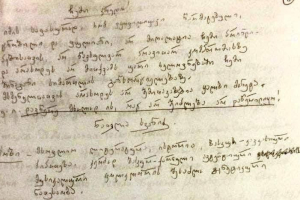Natela
Svanidze
Natela Svanidze
(1926 – 2017)
Natela Svanidze, Georgian composer, teacher. One of the outstanding creators of the 60s generation. The composer, who was not accepted by the Soviet system, and despite this, was able to grasp world musical trends and follow them. Today, his work is known in more than one country of the world.
Honored Worker of Art (1981), member of the Union of Composers of Georgia.
Date of birth – August 22, 1941
Place of birth – St. Akhaltsikhe, Georgia
Date of death – 02 June 2011
Place of death – Tbilisi, Georgia
BIOGRAPHICAL DATA
1951 – Graduated from Tbilisi State Conservatory’s Faculty of Composition under the guidance of Andria Balanchivadze;
1956 – Teacher of Shota Rustaveli State Institute of Theater and Cinema;
Since 1969 – Senior teacher of Shota Rustaveli State Institute of Theater and Cinema;
Since 1989 – Docent of Shota Rustaveli State Institute of Theater and Cinema;
Since 1991 – Professor of Shota Rustaveli State Institute of Theater and Cinema;
She has written 4 symphonic poems: “Symphonic Dances”, “Samgori”, “Kvarekvare”, “Burlesque”, 2 symphonies, oratorios “Firosman” and “Georgian Lamentations”, opera “Gaul Gavkhe”, monodrama…
AWARDS AND RECOGNITION
1959 – Member of the Union of Theater Workers
1951 – Union of Composers of Georgia, member
1981 – Honored Worker of Art
Natela Svanidze
(1926 – 2017)
SELECTED WORKS
ORCHESTRAL MUSIC
1949 – “Symphonic Dances”
1951 – “Samgori” – Symphonic Poem
1963 – “Kvarkvare” – Symphonic Poem
1965 – “Burlesque – for Piano, Wind and Percussion Instruments”
1967 – Symphony for Piano, Strings and Percussion
1968 – Symphony-Ballet for Symphonic Orchestra
1983 – Symphony
VOCAL-INSTRUMENTAL MUSIC
1954 – “Garden of Kartli” – Cantata – for Mixed Choir and Symphony Orchestra – (Text – G. Leonidze)
1970 – “Firosman” – Chamber Oratorio – for Reader, Contralto, Male Sextet and Instrumental Ensemble – (text – P. Antokolski, T. Tabidze)
1974 – Requiem
1975 – “Poem of Unforgetting” (“Georgian Lamentations”) – Oratorio – for Reader, Women’s Sextet, Choir, Organ, Violin, Flute, 12 Cellos and Magnetic Tape – (text – J. Charkvian)
1952 – “Zoya” – Ballad for Bass and Piano
1954 – “Dawn” – for Women’s Choir – a Cappella
CHAMBER-INSTRUMENTAL MUSIC
1956 – Improvisation for Violin and Piano
1954 – “Fairy Tale” – Variation for Piano
1972 – “Circle” – for Two Pianos
Natela Svanidze
(1926 – 2017)
The popularity of Natela Svanidze’s compositions continue to grow over time. This is due to the fact that she is now considered as a “nonconformist,” in addition to the fact that she was one of the composers whose works at the time were controversial and opposed to the Soviet ideology. Jen Parrish
The compositions’ substance, the desire to understand the composer’s uniqueness, and interesting findings are what essentially define interest in her musical legacy.
Musicology brought attention to two phases of Natela Svanidze’s creative process. The first represents an early period when the composer’s creative principles were based on the romantic music genre, and the second represents a more recent period that began as a result of the composer’s voyage to Europe. Marika Nadareishvili, a musicologist and author of a study on the composer’s works, notes that “her style has changed radically since 1963 and is based on new types of 20th- century European compositional techniques and, consequently, on topics and musical language far separated from the Soviet orientation at this time.” From this moment on, the composer’s musical perspectives extended and deepened, and a new perspective, a new understanding of the world, was formed. The avant-garde compositions of Schoenberg, Webern, Boulez, Liget, Lutosławski and Berio – hold a significant place in the wide variety of her musical interests.
The Symphony N1 for piano, strings, and percussion (1965) is the first significant work to demonstrate the author’s radical point of view and avant-garde composition. Here, the author focuses on Arnold Schoenberg’s invention of the sequential system, one of the main representatives of the Vienna New School, whose national origin produces a vivid imagination of events based on fusion. This is the first serial concept of Georgian symphonic.
Conceptual thinking is a concept of Natela Svanidze. The author’s radicalism is demonstrated by the intellectual content and related frequently originally created form of her works. The chamber oratorio “Firosmani” for baritone, contralto, vocal sextet, and chamber orchestra is a clear example of how the composer perceives the world in this perspective (1970).
The great Georgian artist Niko firosmanashvili’s theme of vulnerability is the subject of Natela Svanidze’s composition, and allowed to pull out the accumulated emotional protest against the reality. This also explains why she is so radical and why she desires an unusual sound. Her goal for polystylistic methods is understood as the coexistence of culturally specific and universal concepts, bringing the Georgian hymn’s motif to the forefront within a variety of classical and avant-garde elements. Generally speaking, unique combination of national themes and the serial structure remain one of the characteristic principles of composer till the end.
The composer, Natela Svanidze, continues to keep to the serial system while also including the concepts of aleatorics, sonoristics, polystylistics, and electronic music. As time passes on, composer’s repertoire of expressive styles develops more extensive.
Its worth mentioning that vocal recitation technique known as Sprechstimme, which mixes the Georgian roots with the avant-garde composers of the 20th century, is used frequently in her compositions.
It’s significant that the composer’s viewpoint has changed in that time. The author’s desire for consciousness and understanding the essence of existence is evident from the manner in which her works were presented. The composition “Circle” for arranged and traditional piano reflects Natela Svanidze’s philosophical ideas (1972). Besides, it is fascinatingin terms of structure. By using acoustic, metro-rhythmic contrasts, variations based on the sequential concept can evolve organically.
The composer’s perspective gradually emphasizes the tragic aspect of the theme of life and death, leading to a philosophical generalization of this timeless problem. An oratorio composition called “Georgian Lamentations,” based on a poem by Jansug Charkviani, is performed by a reader, mixed chorus, women’s vocal sextet, violin, alto-flute, organ, 12 cellos, and digital clip (1974). In this composition, the serial principle and aspects of electronic music coexist with traditional national choral polyphonic techniques and folk intonation patterns, making it interesting from the perspectives of musical language, technical capabilities, and dramaturgy.
The monodrama “Drops of blood from the heart” for female voice, two pianos, percussion (pedal board, small cymbal), and three audio recorders can be regarded as the culmination of Natela Svanidze’s creativity (2000). The composition is dedicated to her only daughter, the opera
singer Maya Tomadze, who was gifted with a distinctive voice. The piece’s dramatic structure, which is based on the passage of strong emotions, has timbral effects that have an influence on the listener. By using the poetry of the Georgian poet Terenti Graneli, the composer emphasizes her mystic outlook on life. In some aspects, “Drops of Blood from the Heart”, could be an imitation of Arnold Schoenberg’s monodrama “Expectation” in some ways. But It is an entirely original composition based on Georgian soil. According to composer Eka Chabashvili – ” Natela Svanidze was always attracted to freedom, modernity, and the urge to express one’s national identity. Her music still astounds us with the bravery and sincerity today.”
Musicologist
Tamar Tsulukidze
English Language Translator
Tamar Kharadze
























